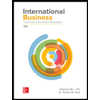tourism destinantion management
docx
keyboard_arrow_up
School
Oxford High School, Oxford *
*We aren’t endorsed by this school
Course
9040
Subject
Business
Date
Nov 24, 2024
Type
docx
Pages
16
Uploaded by EarlDugongMaster616
STUDENT’S NAME
TOURISM DESTINATION MANAGEMENT
Table of Content
INTRODUCTION
...........................................................................................................................
2
Understand the current trends that affect national and tourism destinations
...................................
3
1.1 Analyze the main tourist destination of the world according to visitor number and income
generation
....................................................................................................................................
3
1.2 assess the current trend that affects tourist destinations
........................................................
4
1.3 Analyze future trends in tourist destinations based on industry statistics
.............................
6
Future Trends of France
........................................................................................................
6
Future Trends of china
..........................................................................................................
6
Future Trends of Maldives
....................................................................................................
6
Future Trends of India
..........................................................................................................
7
Examine the characteristics of tourism destinations and their relationship to their appeal
.............
7
2.1 evaluate the cultural, social, and physical characteristics of the tourism destination
............
7
2.2 assess how these characteristics affect the appeal of tourist destinations
..............................
8
Culture, Social, and Physical Characteristics of Indonesia Tourist Destination
......................
8
Culture, Social, and Physical Characteristics of Maldives as Tourist Destination
..........
8
Culture, Social, and Physical Characteristics of Brazil's Tourist Destination
.................
9
Evaluate the characteristics of tourist destinations and their impact on tourist and tourism
...........
9
3.1 explain the characteristics of developing tourist destinations
...............................................
9
3.2 Critically evaluate how the characteristic of a tourist destination affect its appeal to
tourists
........................................................................................................................................
10
Recommendation
...........................................................................................................................
11
Conclusion
.....................................................................................................................................
12
References
......................................................................................................................................
14
INTRODUCTION
Tourism destination management is a crucial aspect of the tourism industry that involves the
planning, development, marketing, and operation of tourist destinations. It refers to the
management of all the resources, services, and activities that contribute to the overall tourist
experience, ensuring that the destination meets the needs and expectations of visitors while also
maximizing economic, social, and environmental benefits for the destination and its host
community.
Tourism destination management is a complex and multifaceted process that requires the
collaboration and coordination of various stakeholders, including government agencies, tourism
organizations, local communities, and the private sector. It involves the identification of the
destination's unique selling proposition, the creation of a strategic plan, and the implementation
of initiatives and activities that enhance the destination's appeal and competitiveness (Afrić
Rakitovac et al., 2019).
The primary goal of tourism destination management is to create a sustainable tourism
destination that offers high-quality experiences for tourists while minimizing negative impacts on
the environment and the host community. This is achieved through careful planning and
management of the destination's physical, social, and economic resources, such as natural
attractions, cultural heritage, infrastructure, transportation, and accommodation.
Tourism destination management also involves the development of effective marketing strategies
to promote the destination and attract the right target market. This includes identifying the
destination's target market, creating a brand image, and developing marketing campaigns that
highlight the destination's unique features and benefits.
Furthermore, tourism destination management also involves the provision of high-quality visitor
services, such as tourist information centers, transportation, and hospitality services, to ensure
that tourists have a positive and enjoyable experience. This requires a collaborative effort
between the public and private sectors to provide the necessary infrastructure and services to
meet the needs of tourists while also ensuring that the local community benefits from tourism.
Your preview ends here
Eager to read complete document? Join bartleby learn and gain access to the full version
- Access to all documents
- Unlimited textbook solutions
- 24/7 expert homework help
Tourism destination management is a critical aspect of the tourism industry that plays a
significant role in shaping the success and sustainability of tourist destinations (Ivars-Baidal et
al., 2019). It involves the coordination and collaboration of various stakeholders, including
government agencies, tourism organizations, local communities, and the private sector, to ensure
that destinations meet the needs and expectations of tourists while also maximizing economic,
social, and environmental benefits for the destination and its host community.
Understand the current trends that affect national and tourism
destinations.
1.1 Analyze the main tourist destination of the world according to visitor number
and income generation.
The main tourist destinations in the world can be analyzed based on their visitor numbers and
income generation. According to the latest available data from the World Tourism Organization
(UNWTO) for the year 2019, the top three tourist destinations in terms of international tourist
arrivals were France, Spain, and the United States.
France received approximately 90 million international tourist arrivals in 2019, generating an
estimated US$60 billion in tourism revenue. Spain received approximately 83 million
international tourist arrivals in the same year, generating an estimated US$83 billion in tourism
revenue. The United States received approximately 80 million international tourist arrivals in
2019, generating an estimated US$214 billion in tourism revenue (Alami et al., 2016).
Other top tourist destinations based on visitor numbers and income generation in 2019 include
China, Italy, Turkey, Mexico, Germany, Thailand, and the United Kingdom.
China received approximately 65 million international tourist arrivals in 2019, generating an
estimated US$50 billion in tourism revenue. Italy received approximately 64 million
international tourist arrivals in the same year, generating an estimated US$53 billion in tourism
revenue. Turkey received approximately 52 million international tourist arrivals, generating an
estimated US$35 billion in tourism revenue.
Mexico received approximately 45 million international tourist arrivals in 2019, generating an
estimated US$24 billion in tourism revenue. Germany received approximately 39 million
international tourist arrivals, generating an estimated US$54 billion in tourism revenue. Thailand
received approximately 39 million international tourist arrivals in the same year, generating an
estimated US$62 billion in tourism revenue. Finally, the United Kingdom received
approximately 36 million international tourist arrivals in 2019, generating an estimated US$47
billion in tourism revenue (Varra et al., 2012).
It is important to note that these figures are from 2019 and do not reflect the impact of the
COVID-19 pandemic on the tourism industry, which has had a significant negative impact on the
number of international tourist arrivals and tourism revenue generated in many destinations
around the world.
The main tourist destinations in the world can be analyzed based on their visitor numbers and
income generation, with France, Spain, and the United States being the top three destinations in
terms of international tourist arrivals. However, the tourism industry has been severely impacted
by the COVID-19 pandemic, and it is likely that the rankings and figures will change in the
coming years.
1.2 assess the current trend that affects tourist destinations.
The tourism industry is constantly evolving, and there are several current trends that are
impacting tourist destinations around the world. Here are a few examples:
Sustainable Tourism:
One of the biggest trends in the tourism industry is the growing
importance of sustainable tourism practices. Tourist destinations are now focusing on promoting
sustainable tourism practices such as reducing waste, conserving natural resources, and
supporting local communities. This trend is driven by the increasing awareness of the negative
impact of tourism on the environment and local communities (Gelter et al., 2021).
Digitalization:
The digitalization of the tourism industry has also been a significant trend in
recent years. The use of technology, such as mobile apps, virtual reality, and social media, has
transformed the way tourists research, plan, and book their travel. Tourist destinations are now
leveraging digital technologies to enhance their marketing strategies and provide personalized
experiences for visitors.
Authenticity:
Tourists are increasingly looking for authentic and unique experiences that allow
them to connect with the local culture and community. Tourist destinations are responding to this
trend by promoting local experiences, such as food and wine tours, cultural events, and
immersive activities that allow tourists to engage with the local community.
Safety and Security:
Safety and security have always been a top priority for tourist destinations,
but recent global events have heightened the importance of this trend (Risteskia et al., 2012).
Tourist destinations are now focusing on enhancing safety and security measures, such as
implementing health and safety protocols, enhancing emergency preparedness, and using
technology to improve security measures.
Wellness Tourism:
Another significant trend in the tourism industry is the growing interest in
wellness tourism. Tourists are now seeking destinations that offer opportunities for relaxation,
rejuvenation, and self-improvement. Tourist destinations are responding to this trend by
promoting wellness activities such as yoga retreats, spa treatments, and meditation.
Domestic Tourism:
The COVID-19 pandemic has had a significant impact on the tourism
industry, and one of the most significant trends to emerge is the increase in domestic tourism.
With travel restrictions and border closures in place, tourists are now looking for travel
opportunities closer to home. Tourist destinations are responding by developing marketing
strategies that target local visitors and promoting regional travel.
Slow Tourism:
Another emerging trend in the tourism industry is the focus on slow tourism.
Slow tourism is all about taking the time to experience a destination fully, immersing oneself in
the local culture and environment. Slow tourism promotes sustainable travel practices, such as
staying in locally owned accommodation and exploring the destination on foot or by bicycle.
The tourism industry is continually evolving, and there are several current trends that are
affecting tourist destinations (Bosnić et al., 2019.). Sustainable tourism practices, digitalization,
authenticity, safety and security, wellness tourism, domestic tourism, and slow tourism are some
Your preview ends here
Eager to read complete document? Join bartleby learn and gain access to the full version
- Access to all documents
- Unlimited textbook solutions
- 24/7 expert homework help
of the most significant trends in the industry today. Tourist destinations that adapt to these trends
will be better positioned to attract and retain visitors while also ensuring long-term sustainability.
1.3 Analyze future trends in tourist destinations based on industry statistics.
Future Trends of France
France is one of the most popular tourist destinations in the world, attracting millions of visitors
each year. The focus on sustainable tourism practices is expected to continue to grow in France,
as it has become a priority for the government and tourism industry. The French government has
set ambitious targets to reduce greenhouse gas emissions and promote sustainable tourism
practices. The development of eco-friendly accommodations, sustainable transportation options,
and local food sourcing are some of the areas that are expected to receive more attention in the
future.
Future Trends of china
China is one of the fastest-growing tourism destinations in the world, with a rapidly expanding
middle class and increasing international tourism. Domestic tourism is expected to continue to
grow in China, driven by the rising middle class and increasing disposable income. According to
the China Tourism Academy, domestic tourism revenue is projected to reach 7 trillion yuan
(about $1 trillion) by 2020 (Hartman et al., 2020). The development of high-speed rail and other
transportation infrastructure is also expected to make domestic travel more convenient and
accessible. China has a rich cultural heritage, with numerous historic landmarks, museums, and
cultural events. Cultural tourism is expected to continue to grow in China, as visitors seek to
experience the country's art, history, and traditions. The development of cultural tourism
infrastructure, such as museums and heritage sites, is expected to attract more visitors to China.
Future Trends of Maldives
The Maldives are a stunning nation in the Indian Ocean. The Maldives is a relatively tiny nation
made up of several islands, each of which is encircled by a clear body of water and offers
stunning scenery. The GDP of the Maldives, despite its small size and significant contribution to
global GDP, is declining due to the COVID epidemic, but it will be fully recovered by 2021
because to the country's excellent tourism industry and ability to draw in visitors. The Maldives
welcomes millions of tourists each year for leisure travel and entertainment, but as their GDP
expands, the cost of living there is increasing due to growing costs on the international market
(Mihalic & Mihalic\, 2019). The GDP percentage was 19.3% in 2022, and it is expected to rise
further thanks to new construction projects for hotels, resorts, and other tourist attractions.
Future Trends of India
One of the biggest nations in the world, India includes Asia, has seven connecting borders with
other nations, and the two countries have a long history together. India is a growing nation with a
million visitors each year, and the Indian government plans to invest 125 billion US dollars in the
travel and tourism industry by the end of 2027. They also have plans to increase their GDP and
create a million jobs, both directly and indirectly.
Examine the characteristics of tourism destinations and their
relationship to their appeal.
2.1 evaluate the cultural, social, and physical characteristics of the tourism
destination.
Evaluating the cultural, social, and physical characteristics of a tourism destination is important
in understanding the destination's appeal and how it can be marketed to potential visitors. Here
are some aspects to consider:
Cultural Characteristics
: A tourism destination's cultural characteristics include its
history, traditions, arts, and customs. This includes the destination's cultural landmarks
and heritage sites, as well as its festivals, music, and cuisine. A destination's cultural
offerings are a significant draw for visitors seeking unique and authentic experiences.
Social Characteristics
: The social characteristics of a tourism destination encompass the
local community, social norms, and values. The hospitality and friendliness of the local
community, as well as the safety and security of the destination, are factors that can
greatly influence visitor satisfaction. Visitors may also be interested in learning about the
local customs and traditions, and how they can engage with the local community
(Sheehan et al., 2009.).
Physical Characteristics:
The physical characteristics of a tourism destination include
its natural and built environment. The destination's topography, climate, flora, and fauna,
as well as its architectural heritage and modern infrastructure, are factors that can greatly
impact visitor experience. Visitors may be drawn to destinations with natural beauty, such
as beaches, mountains, and national parks, as well as to urban destinations with iconic
landmarks and modern amenities.
It is important to note that cultural, social, and physical characteristics are often interrelated and
can influence each other. For example, a tourism destination with a strong cultural heritage may
also have a vibrant local community that celebrates its traditions, and may be situated in a
beautiful natural environment. Effective tourism management involves leveraging the unique
characteristics of a destination to attract visitors while preserving its authenticity and promoting
sustainable tourism practices (Tajtáková & Olejárová, 2021).
2.2 assess how these characteristics affect the appeal of tourist destinations.
Culture, Social, and Physical Characteristics of Indonesia Tourist Destination
People from all over the world travel to Indonesia to learn about its culture, history, temples, and
other attractions. The indigenous people of Indonesia place a high importance on and respect for
its traditions and culture. Locals in Indonesia request that tourists respect their social values, take
care to protect their environment, and bear in mind that Indonesia is known for its peacefulness
and its clean air.
Culture, Social, and Physical Characteristics of Maldives as Tourist Destination
The Maldives is a small nation comprised of multiple islands, and as it has long been a popular
destination for tourists seeking nothing more than pure leisure, the country is devoid of any
significant cultural landmarks. They are utilised by investors in order to construct hotels, resorts,
and restaurants, all of which are important to the cultural life of the Maldives and enrich the
experiences that visitors have. In addition to this, they adhere to the principles of sustainable
development in order to keep the flow of visitors flowing.
Your preview ends here
Eager to read complete document? Join bartleby learn and gain access to the full version
- Access to all documents
- Unlimited textbook solutions
- 24/7 expert homework help
Culture, Social, and Physical Characteristics of Brazil's Tourist Destination
The culture of Brazil is one of the most recognised and well-known in the world because of its
long history of coexistence between people of African and Portuguese descent, which resulted in
the development of a thriving Brazilian way of life. In terms of both language and religion,
Brazilians have a very high level of education . Brazil has a long history of making fun of the
divinity of the Christian faith, and the Brazilian people place a high emphasis on their culture.
The beginning of the social and physical life of Brazilians is marked by the carnivals. The arrival
of Portuguese settlers in 1723 marked the beginning of the city's annual carnival celebration. To
demonstrate their love and generosity to one another, they took to the streets and threw food,
mud, and water into the air. Since then, the celebrations associated with the carnival have been
held on an annual basis.
Evaluate the characteristics of tourist destinations and their impact
on tourist and tourism.
3.1 explain the characteristics of developing tourist destinations.
A tourist place that people visit for the purpose of participating in a specific activity is
known as a tourist destination; this area is also known as a tourist resort. The tourist destination
requires a variety of amenities, including but not limited to food, transportation, shopping,
entertainment, and magnificent vistas. There is no need that the target region be a specific
location; rather, it might be a town, a city, a country, or any other sort of location in a country
with a significant population. Amenities at tourist places and a specific quantity of attractions
that entice travellers are examples of the common traits that are associated with tourism.
Comfort, attractiveness, and accessibility are other frequent characteristics of tourism. The
tendency of the tourist to travel has an effect on their personality, and this propensity may also
reflect the tourist's interests in things like their hobbies, the climate, and their talents. The history
of the tourist, the tourist's living style, the visitor's occupation, and the tourist's age are also
investigated in connection to these factors.
The behaviour of visitors is another factor that is affected by the level of complexity and
intensity. If a tourist's requests are satisfied in any way, the tourist has a positive reaction, but if
those demands are not met in any way, the tourist's reaction is fairly negative and displays his
attitude. On the other side, the degree of difficulty is impacted by the level of familiarity with a
tourist destination. If they are already familiar with the surrounding region, developing popular
tourist spots will be much simpler for them to do. There are two different types of forms: the
conventional cognitive form and the interest evaluation level in several additional characteristics.
Along with a benefit evaluation of the tourist product and its consideration as a prospective
alternative for a trip destination, the feeling and trust of visitors were discovered in the traditional
notion. Also included was an assessment of the benefits of the tourism product. After passing the
first level, you will go on to the interest evaluation level, which will help decide whether or not
the tourist destination fully fits the requirements of the visitor.
3.2 Critically evaluate how the characteristic of a tourist destination affect its appeal
to tourists.
The importance of comprehending the allure of tourist spots cannot be overstated since
doing so enables one to differentiate between the big tourist attractions of today and those that
are still in the process of developing. There are a number of factors that greatly contribute to the
expansion of tourism in these areas. To begin, there is the decision about the vacation
destination, which is synonymous with the amount of curiosity and contentment that is necessary
for tourists to visit any given region. The majority of tourists have their sights set on urban and
exotic places, mountains, historic areas, cultural experiences, and religious landmarks. As a
consequence of this, the interests and preferences of tourists have an impact on the locations that
travellers choose to visit. Access to the location is a significant factor that affects and determines
the attractiveness of the location. in order to get information on the closeness at which visitors
come, the growth of the economy, and the accessibility of transportation, all of which are
essential for linking them to cities. Additional aspects that contribute to a culture's allure are its
traditions, festivals, and religious practises. Their style of life and the relationships they have
with their families are two further examples of the cultural attractions. People engage in travel
for a wide variety of purposes in the other industry. Students in our day and age travel for a
multitude of reasons, including education and safety, to name just two of those causes. These
countries also have excellent healthcare and insurance options, and since tourism is so important
to their economies, they see robust levels of economic activity. On the other hand, there have
also been some impacts that are not particularly good.
The value of the local currency is significantly affected by tourism, which also
contributes positively to the economy. As a result of the country's appeal, tourism is increasing,
which creates more options for mountain climbing, rock climbing, and other types of
adventurous activities. The increasing number of tourists is currently becoming a concern. The
most popular tourist locations in the world are being adversely affected by a number of critical
issues. There are two major issues: one is the lack of available transportation, and the other is the
language barrier that exists among the population. It is not to the nation's advantage to have
wonderful tourist attractions but to be lacking in transportation and communication systems.
India, which is one of the largest countries in the world, has many places that are popular with
tourists; however, the country does not have an enough amount of transportation facilities, and
there is also a language barrier.
The availability of a big and skilled labour pool is the second aspect to consider if the
nation in question possesses one. The lack of proper education and training among the population
of some nations causes a scarcity of available workers in those nations, which in turn has an
effect on the tourism business of those nations. The tourist is then responsible for finding suitable
lodging and ensuring they receive adequate service. The majority of the cultural and historical
attractions did not have suitable housing or support services available. If both the staff and the
food at a hotel are utterly unhygienic, this casts a negative light on the country or tourist
destination in question. Because the regions where tourists live or go do not have adequate
infrastructure and roadways to accommodate their needs.
Recommendation
The management of tourist sites is the focus of this research project, which also
investigates a number of the features and attractions that make the location appealing to visitors.
In a condensed manner, provide recommendations on significant problems and the long-term
viability of tourism places, taking into account all of the traits and attractions. Because of the
importance of technology and its close connection to the travel and tourism industry, more and
more people are seeking employment with travel and tourism businesses as the world draws
closer to adopting it. There is a negative in which, in the future, travellers' technology will
remove the power of people who operate in properties and replace it with robots and other
things. It is not necessary for leisure travellers or other types of travellers to check in at the front
Your preview ends here
Eager to read complete document? Join bartleby learn and gain access to the full version
- Access to all documents
- Unlimited textbook solutions
- 24/7 expert homework help
desk of the hotel in order to make bookings in hotels for the length of time they will be staying
there.
Visitors, on the other hand, are expected to show proper deference to the social, cultural,
and natural life that is present there, as well as to take care of the environment. This pertains to
aspects of their culture, religion, and other customs as well. Because tourism is the primary
source of revenue for the vast majority of countries in the world today, the governments of those
countries have an obligation to protect and promote any natural or cultural features that might
appeal to visitors, such as mountains, cultures, historical sites, or beaches. After all, they
contribute to the economy of their country. In order for visitors to be able to visit these
destinations, enjoy full service, and feel comfortable in tourist zones, the government has to
construct new hotels, resorts, motorways, and dependable transit systems.
Conclusion
The brief study on the management of tourism destinations that was conducted for this
research project. This study investigates the management of tourist attractions and the reasons
why it is important to understand why tourists need to visit certain locations, how doing so
benefits them, and how it alters their perceptions of how lovely and interesting the world is.
Specifically, the study looks at why it is crucial to understand why tourists need to visit certain
locations.
The main study next analyses the five well-known countries in terms of the number of
tourists that visited them as well as the amount of money these countries have generated in recent
years as a result of tourism. Now that you are aware of how rapidly technology is advancing and
how this is altering tourists' perceptions of the world and their motivations for travelling, discuss
the current and future trends in terms of how they affect daily life. Specifically, focus on how
these trends affect how people live their lives. It is essential to have further conversations on the
cultural, social, and physical aspects of tourism. For instance, individuals travel to these sites for
a variety of reasons, including an interest in the local culture and religion, an enjoyment of
meeting new people, and an interest in learning about the traditions and celebrations of the
locals.
The opinions that other people have about these individuals, as well as their religious
practises and cultural norms, are improved as a result of these elements. Therefore, the final case
in which the characteristics of tourist destinations and how they affect their appeal are studied
and how they affect the appeal of tourist destinations discusses how people love to visit tourist
destinations and what efforts make their trip adventures, such as if people love to visit historical
sites or mountains, and the development of tourist destinations and some negative impacts that
make a cause of tourists never wanting to visit this place again, so the destination has a
significant transport infrastructure. This brings an end to the debate and gives some
recommendations that may assist individuals in concentrating on the areas in which they are
making mistakes.
References
Afrić Rakitovac, K., Urošević, N., & Vojnović, N. (2019). Project ArchaeoCulTour: Innovative
Valorization of Archaeological Heritage in Istria County Through Sustainable Cultural and
Creative Tourism.
Springer Proceedings in Business and Economics
, 61–77.
https://doi.org/10.1007/978-3-030-03910-3_5
Alami, T., Tahmasebi, T., Supervisor, A., & Bonnedahl, K. (2016).
Sustainable and smart destination
management Opportunities for the DMO to act as an intelligent agent among destination
stakeholders
.
Bosnić, I., Tubić, D., & Stanišić, J. (n.d.).
ROLE OF DESTINATION MANAGEMENT IN
STRENGTHENING THE COMPETITIVENESS OF CROATIAN TOURISM
.
Gelter, J., Lexhagen, M., & Fuchs, M. (2021). A meta-narrative analysis of smart tourism destinations:
implications for tourism destination management.
Current Issues in Tourism
,
24
(20), 2860–2874.
https://doi.org/10.1080/13683500.2020.1849048
Hartman, S., Wielenga, B., & Heslinga, J. H. (2020). The future of tourism destination management:
building productive coalitions of actor networks for complex destination development.
Journal
of Tourism Futures
,
6
(3), 213–218. https://doi.org/10.1108/JTF-11-2019-0123
Ivars-Baidal, J. A., Celdrán-Bernabeu, M. A., Mazón, J. N., & Perles-Ivars, Á. F. (2019). Smart
destinations and the evolution of ICTs: a new scenario for destination management?
Current
Issues in Tourism
,
22
(13), 1581–1600. https://doi.org/10.1080/13683500.2017.1388771
Mihalic, T., & Mihalic\, T. (n.d.).
Environmental management of a tourist destination : a factor of
tourism competitiveness. SEBLU, ITEF: Sustainability and responsibility in tourism. Researcher
Tanja Mihalic, ITEF (Project merged into ARSO project) View project Task Force on
Sustainability Science Disclosures (TSSD) View project Environmental management of a tourist
destination
A
factor
of
tourism
competitiveness
.
https://www.researchgate.net/publication/269113524
Your preview ends here
Eager to read complete document? Join bartleby learn and gain access to the full version
- Access to all documents
- Unlimited textbook solutions
- 24/7 expert homework help
Risteskia, M., Kocevskia, J., & Arnaudov, K. (2012). Spatial Planning and Sustainable Tourism as
Basis for Developing Competitive Tourist Destinations.
Procedia - Social and Behavioral
Sciences
,
44
, 375–386. https://doi.org/10.1016/j.sbspro.2012.05.042
Sheehan, L., Vargas Sánchez, A., Presenza, A., & Abbate, T. (n.d.).
The Intelligent Destination
Management Organization
.
Tajtáková, M., & Olejárová, M. (2021). Creative cities and knowledge management approach to
culture-based urban regeneration in Slovakia: A model.
Communications - Scientific Letters of
the University of Žilina
,
23
(4), C25–C37. https://doi.org/10.26552/COM.C.2021.4.G25-G37
Varra, L., Buzzigoli, C., & Loro, R. (2012). Innovation in Destination Management: social dialogue,
Knowledge Management processes and Servant leadership in the Tourism Destination
Observatories.
Procedia - Social and Behavioral Sciences
,
41
, 375–385.
https://doi.org/10.1016/j.sbspro.2012.04.044
Related Documents
Recommended textbooks for you

BUSN 11 Introduction to Business Student Edition
Business
ISBN:9781337407137
Author:Kelly
Publisher:Cengage Learning

Essentials of Business Communication (MindTap Cou...
Business
ISBN:9781337386494
Author:Mary Ellen Guffey, Dana Loewy
Publisher:Cengage Learning

Accounting Information Systems (14th Edition)
Business
ISBN:9780134474021
Author:Marshall B. Romney, Paul J. Steinbart
Publisher:PEARSON


International Business: Competing in the Global M...
Business
ISBN:9781259929441
Author:Charles W. L. Hill Dr, G. Tomas M. Hult
Publisher:McGraw-Hill Education

Recommended textbooks for you
 BUSN 11 Introduction to Business Student EditionBusinessISBN:9781337407137Author:KellyPublisher:Cengage Learning
BUSN 11 Introduction to Business Student EditionBusinessISBN:9781337407137Author:KellyPublisher:Cengage Learning Essentials of Business Communication (MindTap Cou...BusinessISBN:9781337386494Author:Mary Ellen Guffey, Dana LoewyPublisher:Cengage Learning
Essentials of Business Communication (MindTap Cou...BusinessISBN:9781337386494Author:Mary Ellen Guffey, Dana LoewyPublisher:Cengage Learning Accounting Information Systems (14th Edition)BusinessISBN:9780134474021Author:Marshall B. Romney, Paul J. SteinbartPublisher:PEARSON
Accounting Information Systems (14th Edition)BusinessISBN:9780134474021Author:Marshall B. Romney, Paul J. SteinbartPublisher:PEARSON
 International Business: Competing in the Global M...BusinessISBN:9781259929441Author:Charles W. L. Hill Dr, G. Tomas M. HultPublisher:McGraw-Hill Education
International Business: Competing in the Global M...BusinessISBN:9781259929441Author:Charles W. L. Hill Dr, G. Tomas M. HultPublisher:McGraw-Hill Education

BUSN 11 Introduction to Business Student Edition
Business
ISBN:9781337407137
Author:Kelly
Publisher:Cengage Learning

Essentials of Business Communication (MindTap Cou...
Business
ISBN:9781337386494
Author:Mary Ellen Guffey, Dana Loewy
Publisher:Cengage Learning

Accounting Information Systems (14th Edition)
Business
ISBN:9780134474021
Author:Marshall B. Romney, Paul J. Steinbart
Publisher:PEARSON


International Business: Competing in the Global M...
Business
ISBN:9781259929441
Author:Charles W. L. Hill Dr, G. Tomas M. Hult
Publisher:McGraw-Hill Education
